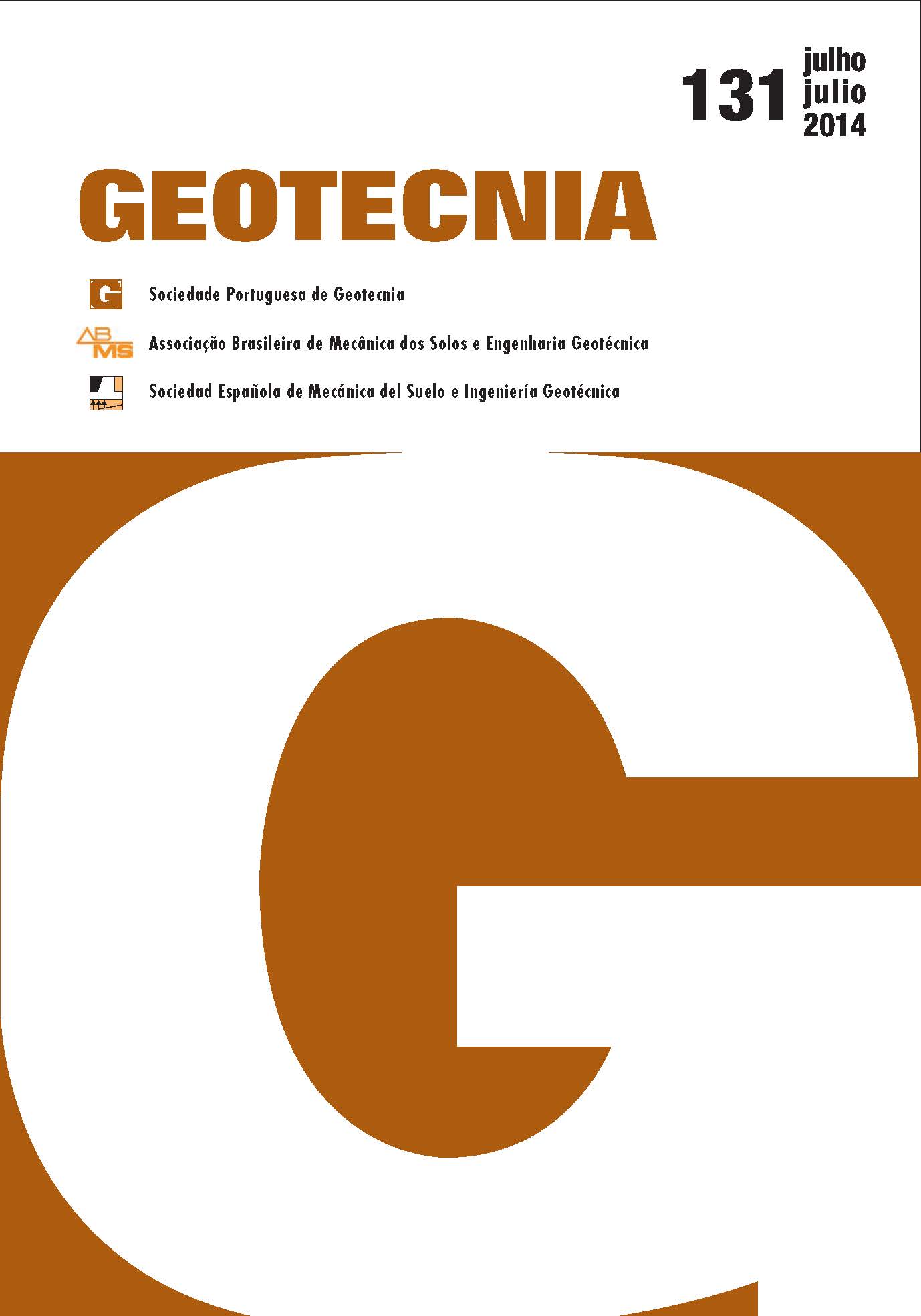Reabilitação de uma linha férrea de mercadorias - Aspetos geotécnicos da via
DOI:
https://doi.org/10.24849/j.geot.2014.131.06Palavras-chave:
Reabilitação de vias-férreas de mercadorias, ensaios não destrutivos, modelação numéricaResumo
Após alguns anos em que o transporte ferroviário teve um declínio acentuado, ultimamente tem vindo a assistir-se, em vários países, à modernização de linhas férreas antigas, nomeadamente procedendo à reabilitação da via-férrea. Vários desses casos referem-se a vias que se pretende que venham a servir essen - cial mente o transporte de mercadorias. Durante a reabilitação das vias férreas existem vantagens técnicas, económicas e ambientais em manter, se possível, os materiais existentes, em particular a camada de balastro ferroviário contaminado com solos finos, sob as novas camadas de reforço. Este trabalho apresenta resultados de estudos realizados com o objetivo de reabilitar uma via-férrea para o transporte de mercadorias, localizada em África. Para além da caracterização realizada in situ, construíram-se trechos experimentais para testar diversas soluções estruturais para reabilitação da plataforma ferroviária e realizaram-se modelações numéricas da via, contemplando essas soluções. Os resultados dos estudos permitiram concluir que é possível levar a cabo o reforço estrutural da plataforma, de forma eficiente, em termos técnicos e económicos.
Downloads
Referências
AASHTO M 145-91 (2004). Classification of soils and soil-aggregate mixtures for highway construction purposes. Standard Specifications for Transportation Material and Methods of Sampling and Testing. American Association of State Highway and Transportation Officials.
ASTM D 2487-06 (2006). Standard Practice for Classification of Soils for Engineering Purposes (Unified Soil Classification System). American Society for Testing and Materials.
AFNOR NF P 94-117-1 (2000). Module sous chargement statique à la plaque (EV2). Association Française de Normalisation.
Castro, G. (1988). Penetrómetros. Penetrómetro estático tipo holandês (CPT). Penetrómetros dinâ - mi cos (SPT) e (PDL) ou (DPL). Informação Técnica, Geotecnia, ITG 11 - LNEC, Lisboa.
Cruz, N. (2010). Modelling geomechanics of residual soils by DMT tests. Dissertação de Douto ra - mento, Faculdade de Engenharia da Universidade do Porto.
Esveld, C. (2001). Modern Railway Track. Ed. 2, MRT-Productions, Zaltbommel.
Fortunato, E. (2005). Renovação de plataformas ferroviárias. Estudos relativos à capacidade de carga. Dissertação de Doutoramento, Faculdade de Engenharia da Universidade do Porto.
Fortunato, E.; Pinelo, A.; Mateus da Silva, J. (2001). The strengthening and upgrade of railway infrastructures: Geotechnical aspects. Proceedings of the XVth International Conference on Soil Mechanics and Geotechnical Engineering, vol. 3, pp. 2069-2072, Istambul.
Fortunato, E.; Resende, R. (2006). Mechanical behaviour of railway track structure and foundation – three dimensional numerical modelling. Proc. of RailFound 06 - International Conference on Railway Track Foundations, pp. 217-227, Birmingham.
Fortunato, E.; Pinelo, A.; Matos Fernandes, M. (2010). Characterization of the fouled ballast layer in the substructure of a 19th century railway track under renewal. Journal of the Japanese Geotechnical Society: Soils and Foundations, vol. 50, nº 1, p. 55-62.
Fortunato E.; Paixão, A.; Fontul, S. (2012). Improving the use of unbound granular materials in railway sub-ballast layer. Proc. of the 2nd Int. Conference on Transp. Geotechnics, Sapporo.
Gomes Correia, A.; Roque, A.J.; Reis Ferreira, S.M.; Fortunato, E. (2012). Case Study to Promote the Use of Industrial Byproducts: The Relevance of Performance Tests. Journal of ASTM International; Vol. 9; n.º 2; pp. 1-18.
Itasca FLAC3D (2006). Fast Lagrangian Analysis of Continua in 3 D. Itasca Consulting Group. ISO 22476-2 (2005). Geotech. investigation and testing-Field testing-Part 2: Dynamic probing.
ISSMFE (1989). Report of the ISSMFE Technical Committee on Penetration Testing of Soils - TC 16, with Reference to Test Procedures; Appendix C: “International reference test procedure for dynamic probing (DP)”. Information 7, 20-23, Swedish Geotechnical Institute Linköping.
Lim, S.; Zollinger, D. (2003). Estimation of the Compressive Strength and Modulus of Elasticity of Cement-Treated Aggregate Base Materials. Transp. Research Record (1837), pp. 30-38.
Muromachi T.; Kobayashi, S. (1982). Comparative study of static and dynamic penetration tests currently used in Japan. Proc. of the 2nd European Symposium on Penetration Tests, ESOPT-2, Amsterdam.
Paixão, A.; Fortunato, E. (2010). Rail track structural analysis using three-dimensional numerical models. Proc. of 7th European Conference on Numerical Methods in Geotechnical Engineering, pp. 575-580, Trondheim.
Selig, E.T.; Waters, J.M. (1994). Track geotechnology and substructure management. Thomas Telford, London.
UIC (2008) CODE 719R. Earthworks and track bed for railway lines, Union Internationale des Chemins de Fer, Paris.




